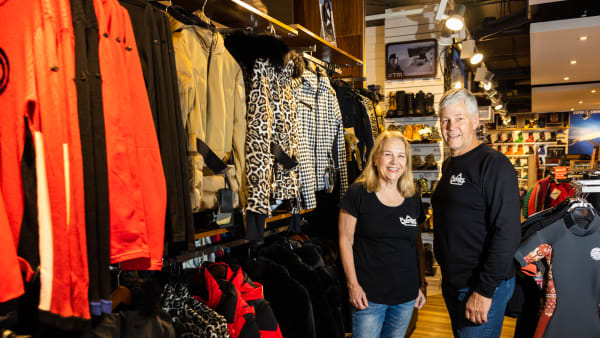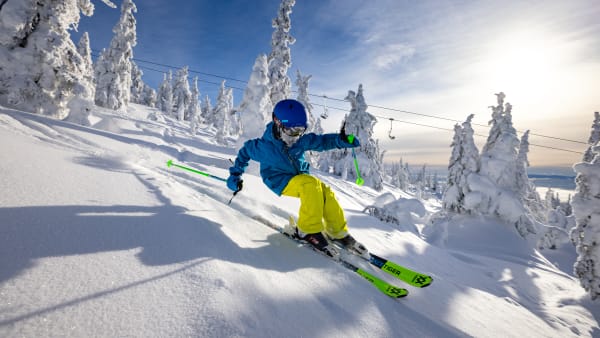FOR a kid from the south coast of New South Wales, what was to be a mere week's holiday at Mt Hotham in 1987 changed Bill Barker's life.
Offered work at the Mt Hotham General Store, Bill stayed for the winter, came back the next year, and next, and is now into his 34th season.
The first day I skied Hotham was the official opening of the Heavenly Valley Chair," Bill recalled.
"The offer of work, while also getting to ski every day was too good to pass up.
"I worked at the general store for several more seasons, then picked up other work after that, including a lot of ski modelling with mountain photographers such as Andrew Barnes."
Fast forward to today and Bill is one of the most recognisable faces on the mountain, in one of the most challenging roles working for Mt Hotham Alpine Resort Management as director of Mt Hotham Ski Patrol.
He has been doing it for around a decade, having first joined the patrol part–time back in 1992, and then full–time in 2000 while recovering from a ski accident suffered in Austria.
"I didn't plan to be here this long, but it's hard to leave," Bill said.
"I just work with such good people and have met most of my best friends up here on the mountain."
Bill has around 30 paid ski patrollers and mountain safety members, as well as another 35 volunteer ski patrollers from across the country and all walks of life.
"On any given day, when the whole mountain is opened, we'll have approximately 15 to 20 patrollers on deck," he explained.
"We work nine to 10 hour shifts, starting well before the lifts begin rolling.
"After every significant snowfall we have to go out at first light to assess how much snow we've had and do any avalanche control work.
"Members will ski and assess runs, mark any hazards, set up netting and any signage needed around lifts and runs before the lifts open each morning.
"They will patrol in their designated areas and respond to any emergencies."
And emergencies sometimes happen in difficult to access locations within the resort and nearby backcountry, so the patrollers also need to be highly skilled in roped evacuation techniques and search and rescue procedures.
Along with rigorous on–mountain training, all ski patrollers need to successfully complete an intensive training course held by the Australian Ski Patrol Association, which largely focuses on medical skills.
"A lot of it parallels some of the skills of paramedics," Bill said.
"In fact, a lot of paramedics work as ski patrollers during the season, and we also have other medical professionals such as doctors, nurses and surgeons in our volunteer ranks.
"Ski patrollers need to be solid expert skiers or snowboarders...they need to be able to confidently get around all terrain in any snow conditions and be able to ski down with a rescue toboggan.
"They don't need to be as technically pretty as instructors though."
Bill said this season, like all others, has ebbed and flowed, be it from snow cover to COVID restrictions.
"During the early part of the season when the snow cover wasn't as substantial as now, there was still significant visitation and we were a lot busier than normal," he said.
"Per capita though, we were still seeing a similar number of incidents.
"For skiers, knee injuries, particularly to ligaments, were common, while for beginner snowboarders wrist injuries were most common.
"You also see dislocated shoulders, fractured clavicles and concussion fairly regularly.
"We tend to see a majority of accidents in the beginner areas, but accidents in advanced areas are generally more serious because of the speed and steepness of terrain."
As we head into spring, Bill said everyone out on the slopes should pay particular attention to the snow conditions.
“The runs can start off really hard but the snow will usually soften for great turns mid–morning but may become too heavy later in the day,” he said.
"South facing slopes can stay rock hard all day, while north facing aspects can lose its snow cover.
“And beware of the snow refreezing once a slope goes into the shade.”
"September is a great time to enjoy the resort but people should know their limitations, ski/snowboard to the conditions, stay hydrated and have a break if you feel tired."
Spring is also a particularly popular time for backcountry adventures – something particularly close to Bill's heart, as he usually spends our warmer months guiding backcountry tours in the Himalayas and Antarctica.
"It's important you understand the snow conditions if you're going out backcountry, and know where to go," Bill said.
"A majority of accidents occur because people have misread the surface conditions.
"The risk of sliding on icy slopes increases in spring…...so be careful out there."








